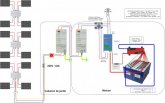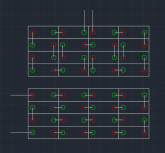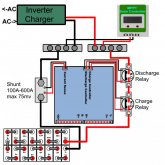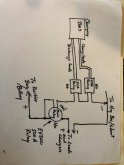I'll chime in as well and strongly suggest two 16S/48V packs in parallel, each with a 16S BMS to manage/monitor all the cells. The redundancy is a key factor, especially if one "Pack" in the battery bank decided to misbehave for some reason. Paralleling Packs is not difficult but can cause problems if not done properly, to that end, Victron wrote up a great guide on wiring your battery packs & banks up properly, here is the link:
https://www.victronenergy.com/upload/documents/Wiring-Unlimited-EN.pdf
The Chargery BMS uses two relay/contactors, one for charge control, the other for discharge control. In a Common-Port Configuration which shares the same DC LLines for both Charge/Discharge an opti-coupler can be used which accepts both relay signal but only actuates a single relay. This is heavily discussed in the Chargery BMS Thread (see my signature). There is also a page of information related to such in the New Chargery 4.1 Owner's Manual (not available yet). The Amperage handled by a BMS which uses relays can easily exceed those with FETS because the relays/contactors are available from 100A to 1000A DC and so they bear the load, not the actual BMS electronics.
Other "Smart BMS" may be an option as well. I should point out that MOSFET Based BMS' are pretty common and are used by many folks with great success. They do have limitations in so far as Amperage Handling because over 200A things have to become quite monstrous and heat dissipation is an issue, especially for the lower cost ones. With these also you ave to have a certain amount of buffer, for example, if you have 200A continuous you would want at minimum a 250A capable BMS so you stay below the maximum threshold of 250A.
Another BMS worthy of serious consideration is the TinyBMS, LIink Here:
https://www.energusps.com/shop/product/tiny-bms-s516-150a-750a-36?category=4 which is a very capable & solid BMS that also is very flexible & configurable, depending on your use case, needs and wants. NOTE the prices there are shown in
€ Euros
A consideration prior to buying more gear. 280AH EVE Cell pack can accept a heavy charge as well as discharge @ 1C which is 280A. It does take a significant amount of juice to charge these babies! The deeper the discharge the longer it takes to charge them up. Quite often people forget to calculate their solar charging capacity based on the LOWEST SUN HOUR DAYS which depends on your locality. This Solar Angle Calculator is lightweight but VERY handy, just select your location details from the dropdown lists and it will give you the basics without much fussing around. LINK HERE:
http://www.solarelectricityhandbook.com/solar-angle-calculator.html
Hope it helps, Good Luck.
Steve








